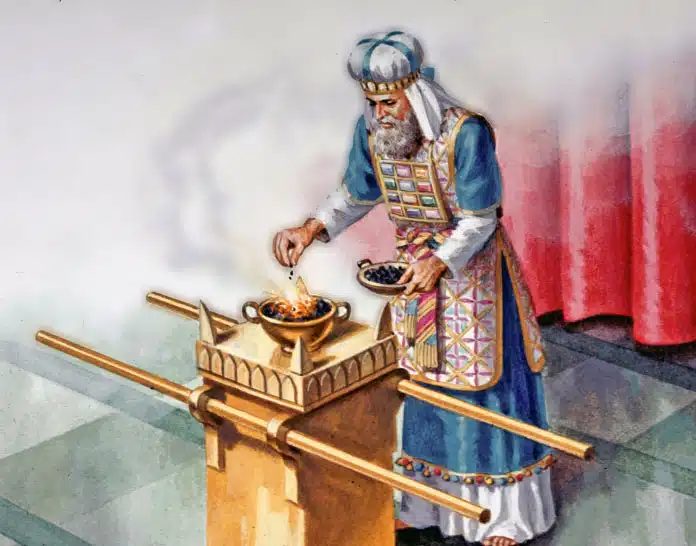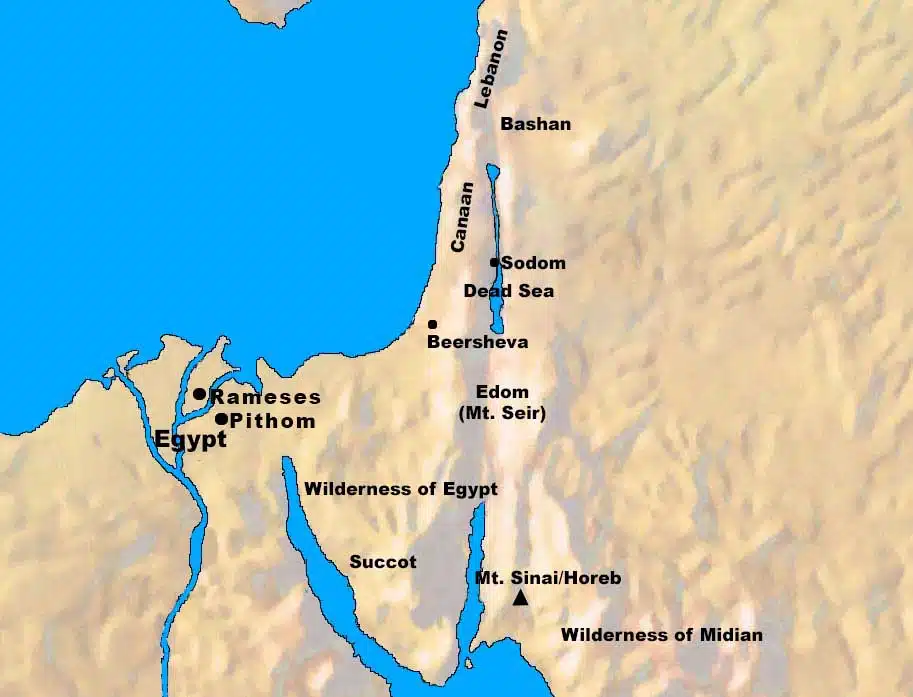The LORD describes how the ephod was to be made. It was an outer piece of clothing that covered the upper body of the priest. The material was similar to the curtains of the tabernacle. It was to be made by skilled craftsmen.
The first item to be created for the priests was an ephod. It was mentioned first because it was the most important item associated with the high priest and the other priests as well. This is the Hebrew word for an article of clothing that was an outer garment that went over the priest’s shoulder and covered his upper body. It was to be made of gold, of blue and purple and scarlet material (probably wool) and fine twisted linen, making it similar to the curtains of the tabernacle. It was to be the work of the skillful workman.

Since the ephod did not have sleeves, it was to have two shoulder pieces joined to its two ends, meaning that two straps were to connect the front and back of the ephod and rest on the priest’s shoulder. In this way, the two sides could be joined. Similar in construction to a breastplate.
Along with the ephod, there was to be a skillfully woven band. The band was probably a piece of material that went around the priest’s waist, similar to apron strings. It was to be made like its workmanship, meaning the band was to be made in a way similar to the ephod itself. It was to be comprised of the same material: of gold, of blue and purple and scarlet material and fine twisted linen.
On the ephod, there were to be two onyx stones.The skilled artists were to engrave on them the names of the sons of Israel. They were to place six of their names on the one stone and the names of the remaining six on the other stone, according to their birth. So the names of the six oldest sons (Reuben, Simeon, Levi, Judah, Dan, & Naphtali) were engraved on one stone and the six younger sons’ names (Gad, Asher, Issachar, Zebulun, Joseph, & Benjamin) were engraved on the other stone.
The skilled artist, in this case a jeweler, was to engrave the two stones like a jeweler engraves a signet. A signet was an engraved object used to create a personalized signature. Kings used them to make documents official, by imprinting their signet on a seal. 1 Kings 21:8 translates this same word in this passage “signet,” as “seal.”
God also ordained a gold setting for these two onyx stones. God commanded: you shall set them in filigree settings of gold. A filigree was a gold setting into which the stone was to be placed.
Once this was completed, the two stones were to be put on the shoulder pieces of the ephod. It seems the two stones would have adorned the same place a modern military officer shows their rank, on their shoulder-piece. They served as stones of memorial for the sons of Israel. God placed importance on Israel remembering its familial heritage, as well as remaining together as a nation.
Including a master lesson in communication, God again repeats the lesson: and Aaron shall bear their names before the Lord on his two shoulders for a memorial. There may be symbolism here, that when Aaron the high priest went into the Holy of Holies, he represented all twelve tribes before the LORD. They are all being remembered before the LORD. Of course God would not forget them, but this reminds Israel that God chose all of them to be His holy people, all twelve tribes.
Verse 13 repeats the command to make filigree settings of gold. Adorning the two filigrees were two chains of pure gold which were to be made of twisted cordage work, similar to a braided chain. Then they were to put the corded chains on the filigree settings.
The ephod probably served several roles:
It might have represented God covering the sinfulness of the priest with His grace, while he was in the LORD’s presence.
It was a beautiful piece of clothing, probably designed to reflect the beauty of the LORD Himself.
Because of the stones with the names of the twelve tribes on the ephod, the high priest wore the ephod when making intercession for the people. Thus, the ephod could be associated with the intercessory role of the high priest.
Now, Jesus Christ is the High Priest of all who believe in Him for everlasting life (Heb. 2:17; 3:1; 4:14; 8:1; 9:11 et al.), and He intercedes for us before the Father on our behalf (Heb. 7:24 – 28).
Biblical Text:
6 “They shall also make the ephod of gold, of blue and purple and scarlet material and fine twisted linen, the work of the skillful workman. 7 It shall have two shoulder pieces joined to its two ends, that it may be joined. 8 The skillfully woven band, which is on it, shall be like its workmanship, of the same material: of gold, of blue and purple and scarlet material and fine twisted linen. 9 You shall take two onyx stones and engrave on them the names of the sons of Israel, 10 six of their names on the one stone and the names of the remaining six on the other stone, according to their birth. 11 As a jeweler engraves a signet, you shall engrave the two stones according to the names of the sons of Israel; you shall set them in filigree settings of gold. 12 You shall put the two stones on the shoulder pieces of the ephod, as stones of memorial for the sons of Israel, and Aaron shall bear their names before the Lord on his two shoulders for a memorial. 13 You shall make filigree settings of gold, 14 and two chains of pure gold; you shall make them of twisted cordage work, and you shall put the corded chains on the filigree settings.
Check out our other commentaries:
-
Exodus 31:12-17 meaning
The LORD gives a strong reminder that, in spite of their spiritual duty to build the tabernacle and the furnishings, the craftsmen are required to...... -
Deuteronomy 22:28-29 meaning
Moses gave the law designed to protect an unengaged virgin who may have been a victim of rape....... -
2 Thessalonians 1:6-10 meaning
The Thessalonians should bear in mind that God will properly repay those who are attacking them. Eventually, there will be relief and peace for believers...... -
Matthew 13:33-35 meaning
Jesus compares the kingdom of heaven to leaven hidden in flour resulting in a feast’s worth of bread....... -
Romans 14:10-12 meaning
We all have to answer to God for the way we’ve individually lived our lives. If something we do in the freedom Christ gives us......



